
|
Sale 81
The Pre-Long Beach Sale
| Lot |
Photo |
Description |
Realized |
Lot 973 |
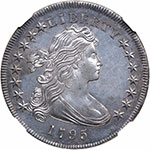 |
1795. Draped Set Left B-14, BB-51 Rarity 2. NGC graded MS-64 Star PL. Marvelous light golden iridescence graces both sides of this spectacular Draped Bust Dollar. A truly wonderful choice. Phenomenal prooflike surfaces. Has the appearance of a specimen striking. Both sides display balanced and natural shades of light old-silver color. The visual appeal is superb on both sides. Fully struck from centering dot to rims including complete stars, just a tiny flat spot on the eagle's chest and forward leg. A handsome, detailed, and incredibly well made and preserved 1795 Draped Bust dollar! Importantly, there are no adjustment marks visible, which sets this apart from most others who show them in places often inside the rims. We might also impress upon the reader that any contact marks that are present are trivial. Not just light, but trivial in the extreme. Certainly among the handpicked ambassadors of its Bust Dollar design, this example earns its place in the collection of a numismatist who recognizes the value of aesthetic beauty as well as rarity. Pop 1; none finer at NGC for the variety. Only 2 BB-51 examples graded Prooflike by NGC (PCGS # 39996) .
Variety Notes: BB-51 represents the very first appearance of the new Draped Bust dollar design coined during 1795. On the obverse, the portrait of Liberty is somewhat off-center and to the left, leaving her lowest curl very close, almost crowding star one, which the fellow with the star punch had to position exactly in the small space provided. The reverse displays a newly rendered eagle perched in the clouds, with an olive branch to the left and a palm branch to the right. This exact reverse die, bearing lettering in a small font, went on to be re-used for coinage through the year 1798!
A short, prominent die scratch extends up to left from tip of right, inside leaf below (observer's) left wing. A berry under A of STATES is a quick way to identify this reverse. This reverse die, as we said, is one of the most remarkable in all of American numismatics, and was mated with obverse dies bearing four different dates. The features are cut in shallow enough relief, and the rim is being relatively low, this must have contributed to its longevity. Many later impressions from the die appear somewhat flat, a situation particularly evident on post-1795 coins in VF or lower grades. The shallow relief does not materially affect the appearance of higher grade coins, which often have exquisite detail as seen here and including an almost full complement of eagle feathers.
Reverse die used to strike 1795 BB-51; 1796 BB-62, BB-63, and BB-66 (now relapped); 1797 BB-72; and 1798 BB-81.
According to the Bowers encyclopedia when describing the first use of this new design in 1795: "The obverse and reverse punches for the 1795 Draped Bust dollar far exceeded in quality anything created earlier. If [John] Eckstein did the Draped Bust and Small Eagle device punches, he is certainly deserving of a niche in the Pantheon of numismatic notables, for the Draped Bust motif went on to be used for many years, not only in the silver dollar series, but with other denominations from the half cent to the half dollar. The Small Eagle reverse, too, is a masterpiece of intricate engraving."
Estimated Value $200,000-UP.
View details and enlarged photos
Check results on similar lots
| Realized
$223,250 |
Lot 974 |
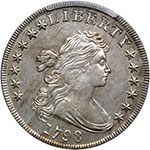 |
1798. B-15, BB-112, Rarity 3. PCGS graded MS-61. Mostly untoned. A smoothly lustrous base-level Mint State with far superior surfaces and originality to most MS61 Bust Dollars we�ve seen. This superiority accompanies the mainly untoned silver color and is enhanced by everything being well balanced with no surprises or disturbance. The reverse and obverse centers play host to a complete if muted luster and originality always appreciated by the stronger buyers. In short, a lovely coin, one that certainly meets the qualifications for the grade.
Noteworthy are very sharp stars and most hair curls. Only the central strands failed to be struck completely. Next, we see something similar with the reverse, where the sharpest design features lie away from the center, and softness occurs at the eagle�s neck and shield below where, again, the dies did not press the planchet squarely enough to fill all the die recesses. Pop 1; none finer at PCGS for the variety. (PCGS # 40029) .
As we have noted elsewhere in the sale pertaining to early United States coins, prior to 1836, the Philadelphia Mint used only screw presses, in which weighted arms were swung by, as the Bowers silver dollar encyclopedia refers to them, "strongly muscled men." The screw was driven downwards with immense force, and the planchet was transformed into a coin by being squeezed between the obverse and reverse dies. Yet the force required to strike such a large diameter piece necessitated consistent strength from the arm of the coiner. Only the Greek allegorical figure Hercules could have sustained such energetic activity throughout the day! Is it any wonder that many early bust coins, not merely the grand-format Bust Dollar, sometimes come up short?
There are several varieties of the Draped Bust dollar (heraldic eagle reverse) for 1798. The differences are rather minor for the obverses, primarily consisting of wide or close dates and knobbed or pointed 9s, this BB-112 die featuring a wide date with a pointed 9. For the reverse we find the so-called arc and diamond-shaped star patterns, but these probably do not reflect policy but rather differing individuals in the engraving department helping Scot prepare the dies. One reverse die even has 10 arrows instead of the standard 13. Many of the minor details in the die-such as berries, stars, and arrows-were added by hand after the main design hubs were punched into a blank die. Bowers suggests there might have been more than one person seconded to the engraving department from other areas of the institution as the need arose.
Estimated Value $26,000 - 28,000.
Ex Miller Collection.
View details and enlarged photos
Check results on similar lots
| Unsold |
Lot 975 |
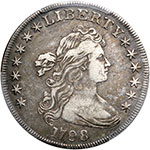 |
1798. Large eagle, close date. B-25, BB-123, Rarity 4. PCGS graded VF-30. Light gray toning on both sides whose pleasing originality is there for all to see, a mellow gray patina, somewhat deeper in the shield stripes, while lighter shades accent the high points. Large production runs began in 1798, after much smaller mintage in 1796 and 1797. Since die life was short back in the 1790s, this forced the Mint to use numerous new dies, each with its own peculiarities and charm. No two are quite alike. This makes the early bust series all the more interesting (PCGS # 6873) .
Estimated Value $2,500 - 2,800.
View details and enlarged photos
Check results on similar lots
| Realized
$2,409 |
Lot 976 |
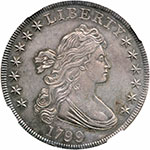 |
1799. B-11, BB-161, Rarity 3. NGC graded MS-63. Nice shades of gold and blue toning. The powerfully struck, lustrous surfaces are readily appreciable at all angles. This is an important issue among choice quality Bust Coin type collectors. No one can honestly deny the vibrancy of the surfaces. This, too, shows in the fully struck devices exhibiting fine detail to all the high points. A very impressive 1799 Draped Bust Silver Dollar, to say the least, and worth bidding on.
First used on the Quarter Eagle in 1796, Robert Scot's rendition of the Great Seal of the United States took its place on the Silver Dollar beginning in 1798. This Large Eagle reverse, as it has since become known (also called Heraldic Eagle), replaced the Small Eagle motif that had originally been mated with the Draped Bust obverse. The new design would remain in use until President Thomas Jefferson suspended Silver Dollar production early in the 19th century.
The Draped Bust, Large Eagle Silver Dollar is one of the classics of U.S. numismatics. Harkening back to the earliest years of our formative nation, these large silver coins are windows into the United States of the founding fathers. The 1798, 1799 and 1800 are the most frequently encountered Draped Bust, Large Eagle Silver Dollars in today's market. The 1801, 1802 and 1803 are scarcer. The 19,570 Silver Dollars delivered in 1804 were struck from 1802 and/or 1803-dated dies.
In addition to type and date collecting, variety specialization is a popular way to pursue the Draped Bust, Large Eagle Silver Dollar series. Since the Mint used multiple individually engraved dies to strike each issue of this type, the astute numismatist can often discern bold naked-eye differences between examples bearing the same date. Many of the die marriages in this series are rare and command significant premiums in the market.
BB-161�s reverse, a sturdy piece of hardened steel, found use in several pairings with other obverse dies. Diagnostics: There are no berries on the branch. U in UNITED defective at upper left part, which is cut off, due to the employment of a defective punch. A point of a star touches the point of the lower part of the eagle's beak; a ray points to the left serif at left side of U in PLURIBUS. The star under cloud 1 is noticeably smaller than any other. A in AMERICA rests on 4th feather. Leaf point is under left side of upright of I. Upper right star has only one point touching cloud 8 (whereas two points of the same star touch the cloud on the reverse of BB-157). Far right edge of A is over junction of clouds 3 and 4. No berries on branch (one tiny remnant of a stem can be seen), as the die was reground earlier (see description under 1799 BB-158). This is the terminal state of this die, after having mated with four obverses including this one. This Reverse was first used to strike 1799 BB-158, during which time it had its first relapping (berries weak), next coining BB-159, then BB-158 again, then, second relapping (removing berries), BB-160 and, finally, BB-161. Pop 2; none finer at NGC for the variety.
Estimated Value $40,000 - 45,000.
View details and enlarged photos
| Unsold |
Lot 977 |
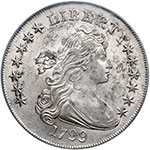 |
1799. B-15, BB-152, Rarity 3. PCGS graded MS-62. A very attractive piece with plenty of original mint luster. It is unusual to find a Mint State quality 1799 Bust Dollar. But when we do, this is how collectors wish it would look. Abundant frosty luster on both sides, of an especially satiny nature on the reverse, enough for this coin and seemingly another one, with luster to spare! The even silver bright surfaces show delicate and traces of toning here and there, mostly present in a band across the reverse. Nicely struck everywhere but the eagle's breast feathers and a few of the reverse stars which tend to be obscure; as pretty as a picture with only a few minor marks. Typical late die state with die breaks on both sides. We expect the coin will attract numerous collectors and prospective buyers who would find this fine piece highly satisfactory! Pop 20; 27 finer at PCGS. (PCGS # 6878) .
Historic Note: Following the transition made from the Small Eagle reverse to one with a Heraldic or Large Eagle in 1798, for calendar year 1799, the quantity of silver dollars minted reached an unprecedented 423,515 pieces. However, experts like Bowers (who produced the definitive encyclopedia of Silver Dollars) thought that many of these were dated 1798. As Bowers notes: "At the time, little attention was paid to the use of dies in the year they were dated. The net coinage of 1799-dated dollars amounted to an estimated 395,000 (within 10%). Some of these may have been minted in calendar year 1800."
Among the production of 1799-dated dollars were some coined from an obverse die overdated 1799/8. Curiously, these were not the first struck. In those days, the working dies for 1799 dollars were prepared as follows:
For the obverse dies: The bust of Liberty was punched into the die, after which the letters of LIBERTY, the stars, and the digits in 1799 were all added with individual punches. There were two sets of numeral punches used, each with Pointed 9, one has a narrow 7 and with spur at bottom of top curve of 9. A later style has a wider 7 and without a spur at bottom of top curve of 9.
For the reverse dies: The Heraldic Eagle motif was punched into the master die. The master die included the eagle, clouds above the eagle, the upper part of the olive branch, olive leaves, and arrows. (Earlier, arrow details were added by hand, but in 1799 they were punched as a group, and are thus similar from coin to coin, unlike the situation in 1798). Working dies were copied from this master die. Added separately to the working die were the letters of UNITED STATES OF AMERICA, the stars above the eagle, the lower part of the olive branch, and the berries. Hence, the wide variance in these features which delineate the various Die Varieties for 1799 (and later dates).
Estimated Value $35,000 - 40,000.
View details and enlarged photos
Check results on similar lots
| Unsold |
Lot 978 |
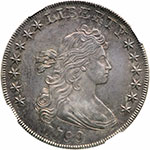 |
1799. B-12, BB-160, Rarity 3. NGC graded MS-62. Lovely, blue and gold toning. A simply first-rate coin whose strong mint original and lovely toning on both sides display ample evidence for why the grading service chose the MS62 grade. The devices are smooth and satiny below the toning, and show a microscopic texture seen sometimes on this die pairing, notably on Liberty. Fully struck by the dies. We describe it the perfect Type coin for any collector who stresses eye appeal, quality surfaces, and a boldness of detail when deciding. The coin is free of adjustment marks, or anything else for that matter to distract the eye, with the absent surface nicks or bumps improving the appearance many times over. This particular coin has only minor affecting six stars behind the eagle's head. This same characteristic can be seen on other Bust Dollars, of course, since this area lies opposite a high point (Liberty's bosom) on the obverse where often the metal failed to flow entirely into the die recesses. Although not the finest known of this variety, certainly well past the mid-range within the Condition Census. An excellent specimen for the collector who requires a high grade Type coin that has all the visual impact of a Gem, without the lofty expense. Pop 19; 47 finer at NGC.
Historic Note: In striking Silver Dollars, prior to 1836 the Mint used only screw presses, in which weighted arms were swung by strongly muscled men. The screw was driven downwards with great force, and the planchet was transformed into a coin by being squeezed between the obverse and reverse dies. There was an improved automatic feeding mechanism installed in the presses in 1795, apparently at the suggestion of John Harper.
In March 1836 the steam press was introduced to the Mint but did not strike silver dollars until the more general coinage that began in 1840. (The knuckle-action steam press operates on a different principle than the screw press.) David Gilbert, an employee of the Philadelphia Mint, invented an improved press in 1858, while in 1874, Coiner A. Loudon Snowden devised additional modifications. Several technical changes have been made since that time, but in essence a device similar in principle to the steam coining press of 1836 is still in use although it is now operated with electrical motors.
Before the coins were struck, however, the planchet blanks were placed on a hand-operated edge lettering machine, between two parallel bars, one fixed, one movable, each bearing half the edge device. A workman cranked the movable bar to impart the design. For the silver dollar this consisted of the wording HUNDRED CENTS ONE DOLLAR OR UNIT in capital letters with ornaments between words.
Before being struck, the blank was cleaned, but there was also a dilute acid treatment (usually sulfuric) to remove any surface oxidation. The blank was then sent to the coining rooms, to receive the impressions from the dies installed in the screw presses.
Estimated Value $25,000 - 27,000.
View details and enlarged photos
| Unsold |
Lot 979 |
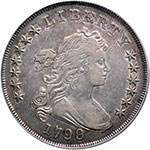 |
1799/8. 15 stars on reverse. B-3, BB-141, Rarity 3. PCGS graded EF-45. Light golden toning. Noticeable 8 beneath the final 9 in the date. Well struck with some minor surface marks, none suggesting they need to be mentioned specifically, and the rims are quite sharp. Centers are slightly weak at Liberty�s lovelock curl (the lone one on her neck) while portion of the eagle and scroll are indistinct due to the dies deteriorating. Some noticeable die breaks are found on both sides. While there are normally 13 stars in an array above the eagle on Heraldic Eagle dollars, on this die the engraver accidentally punched in two extras. The clouds hide two of them so that only the tips of a couple of points are visible. An interesting feature! Pop 36; 74 finer at PCGS. (PCGS # 40064) .
Estimated Value $5,000 - 5,500.
View details and enlarged photos
Check results on similar lots
| Realized
$5,875 |
Lot 980 |
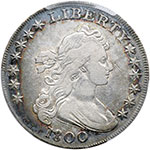 |
1800. 12 arrows. B-13, BB-193. Rarity 4. PCGS graded Fine-15. Lightly tone around the obverse edges. A pleasing example for the grade (PCGS # 6890) .
Estimated Value $1,300 - 1,400.
View details and enlarged photos
Check results on similar lots
| Realized
$1,704 |
|
|